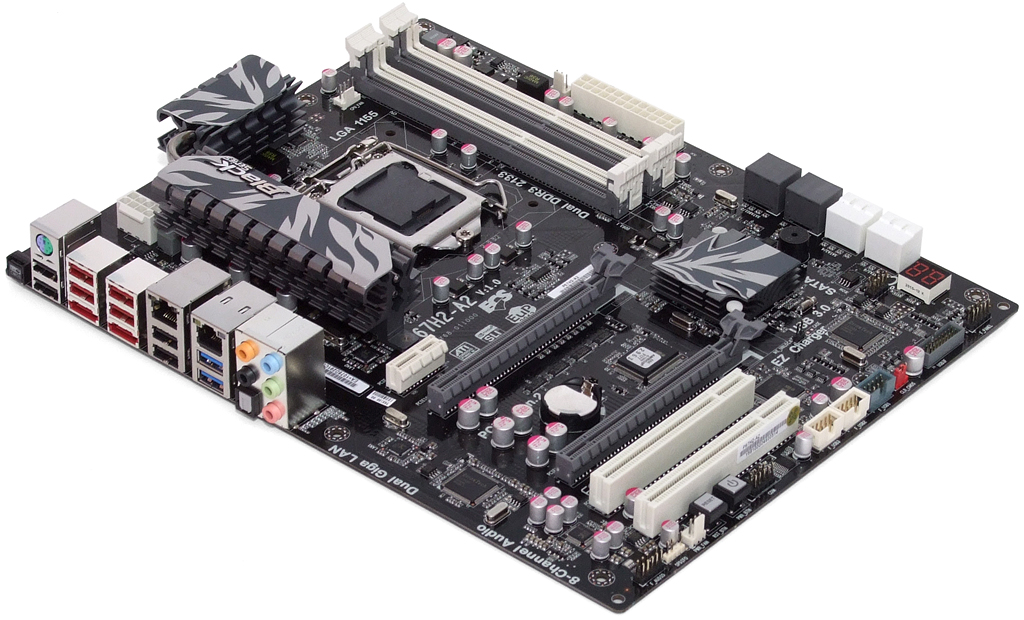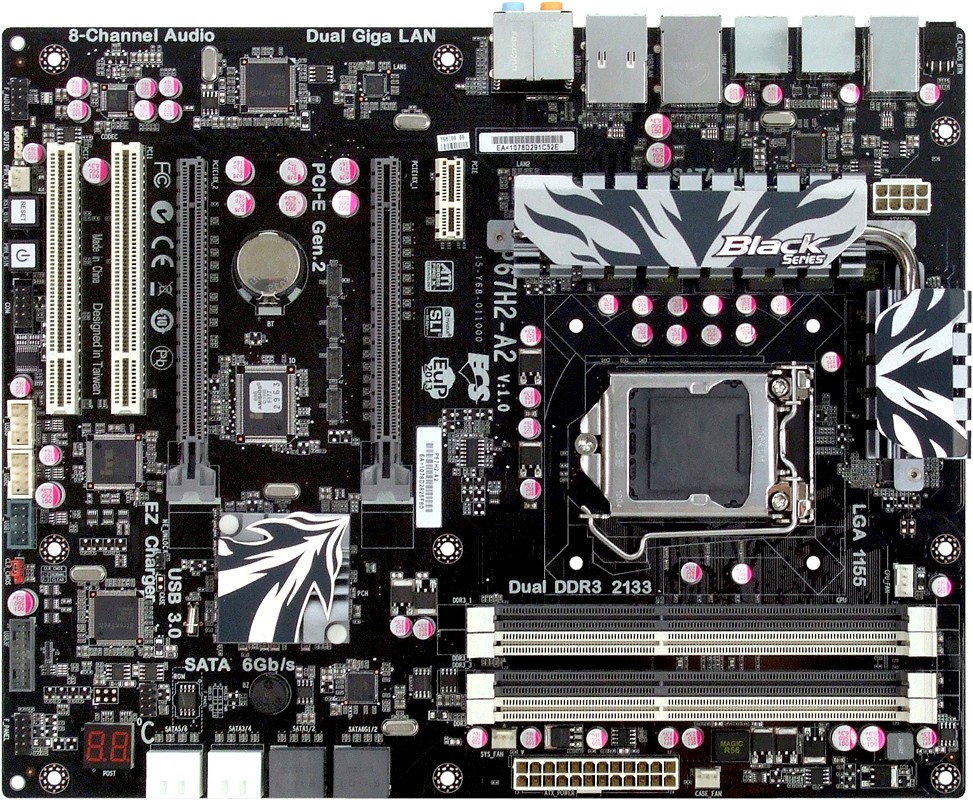P67 Motherboard Roundup: Nine $150-200 Boards
Improved per-clock performance and higher achievable frequencies are sure to put Intel’s latest K-Series CPUs on top of many builders’ whish lists, but they’ll still need a new socket to put it in. We test nine enthusiast-oriented LGA-1155 motherboards.
ECS P67H2-A2
ECS’ continued effort to crack the enthusiast market has produced its most advanced design to date, the P57H2-A2. The design begins with a rear-panel port selection that offers the greatest possible amount of connectivity and extends to a well-organized PCB packed with added features.
ECS knows that a knowledgeable enthusiast probably won’t likely cripple a third graphics card by using a four-lane slot, and instead focuses on providing a good layout for two cards at triple-slot spacing. The company similarly knows that high-performance graphics cards require two slots, so leaving the position under the top card vacant allows for a cleaner design. Automatic switching between single x16 and dual x8 modes allows good SLI and CrossFire performance without the added cost of an NF200 bridge.
An added SATA 6Gb/s controller expands internal ports to eight, while a second added controller provides two eSATA 6Gb/s ports. This is one of the few boards within its price class to include two controllers and, better still, both have been upgraded to RAID-capable versions. Combine that added drive support with dual gigabit Ethernet and two of EtronTech’s improved-performance USB 3.0 controllers for dual front-panel plus dual rear-panel ports, and the P67H2-A2 begins to look out of place in a market full of stripped-down competitors.
The popularity of Windows 7 is well-deserved by contrast to Windows Vista, and that means legacy connectors that were often used with Windows XP are no longer significant. ECS gets rid of most of that stuff, retaining a serial port for use with the legacy diagnostics devices of some corporate customers. A single PS/2 port is also retained for finicky owners of clicky-keyboards or legacy mice.
The lack of a four-lane graphics card slot at the bottom of this board means that we need not worry about graphics card coolers conflicting with front-panel connectors, but we can still make our almost-universal complaint about the front-panel audio connector being too far away from the front-panel jacks of most cases, since it’s tucked away in the usual bottom-rear corner location.
ECS was the first motherboard manufacturer we’ve known to provide a convertible front-panel/slot plate USB breakout, but that was way back in the USB 2.0 days. Its USB 3.0 bracket is improved both electrically and visually, featuring a black-dyed brushed-aluminum finish. ECS adds even more value to its installation kit by being the only manufacturer to include a full set of internal SATA cables.
Get Tom's Hardware's best news and in-depth reviews, straight to your inbox.
-
reprotected I thought that the ECS looked pretty sick, and it did perform alright. But unfortunately, it wasn't the best.Reply -
rantsky You guys rock! Thanks for the review!Reply
I'm just missing benchmarks like SATA/USB speeds etc. Please Tom's get those numbers for us! -
rmse17 Thanks for the prompt review of the boards! I would like to see any differences in quality of audio and networking components. For example, what chipsets are used for Audio in each board, how that affects sound quality. Same thing for network, which chipset is used for networking, and bandwidth benchmarks. If you guys make part 2 to the review, it would be nice to see those features, as I think that would be one more way these boards would differentiate themselves.Reply -
VVV850 Would have been good to know the bios version for the tested motherboards. Sorry if I double posted.Reply -
flabbergasted I'm going for the ASrock because I can use my socket 775 aftermarket cooler with it.Reply -
stasdm Do not see any board worth spending money on.Reply
1. SLI "support". Do not understand why end-user has to pay for mythical SLI "sertification" (all latest Intel chips support SLI by definition) and a SLI bridge coming with the board (at least 75% of end users would never need one). The bridge should come with NVIDIA cards (same as with AMD ones). Also, in x8/x8 PCIe configuration nearly all NVIDIA cards (exept for low-end ones) will loose at least 12% productivity - with top cards that is about $100 spent for nothing (AMD cards would not see that difference). So, If those cards are coming as SLI-"sertified" they have to be, in the worst case, equipped by NVIDIA NF200 chip (though, I would not recommend to by cards with this PCIe v.1.1 bridge). As even NVIDIA GF110 cards really need less than 1GB/s bandwidth (all other NVIDIA and AMD - less than 0.8GB/s)and secondary cards in SLI/CrossFire use no more than 1/4 of that, a normal PCIe v.2.0 switch (costing less than thrown away with x8/x8 SLI money) will nicely support three "Graphics only" x16 slots, fully-functional x8 slot and will provide bandwidth enough to support one PCIe v.2.0 x4 (or 4 x x1) slot(s)/device(s).
2. Do not understand the author euphoria of mass use of Marvell "SATA 6G" chips. The PCIe x1 chip might not be "SATA 6G" by definision, as it woud newer be able to provide more than 470GB/s (which is far from the standard 600GB/s) - so, I'd recommend to denote tham as 3G+ or 6G-. As it is shown in the upper section, there is enough bandwidth for real 6G solution (PCIe x8 LSISAS 2008 or x4 LSISAS 2004). Yes, will be a bit more expensive, but do not see the reason to have a palliative solutions on $200+ mobos.
-
I was hoping that the new Asus Sabertooth P67 would be included. Its new design really is leaving people wondering if the change is as good as they claim.Reply



